Purpose of chemical peels – predictable damage to the skin and its accelerated exfoliation – is achieved through targeted exposure to chemicals of a certain concentration. Cytokines and inflammatory mediators, which are produced in the skin in response to damage, provide an increase in the thickness of the epidermis and the volume of the dermis, mainly due to the active production of collagen.
The depth of penetration and the degree of skin damage are the factors on which the classification of chemical peels is based: superficial, middle and deep. In this article, Dr. Raul Cetto spoke about the features of using medium-length chemical peels.
Medium peels: mechanism of action and indications
Medium peeling affects the papillary and upper reticular layers of the dermis, located at a depth of approximately 0.45 mm.
Predictable and controlled skin damage with medium peels is ensured through the use of:
Trichloroacetic acid in a concentration of 35-50%
Can be used to eliminate signs of photoaging, in particular:
• wrinkles of medium depth in the perioral area.
Follow us on Instagram!
TCA is not suitable for eliminating the problem of sagging skin or deep expression lines - deep peels are better suited for this. TCA denatures the protein, which in turn leads to keratocoagulation and death of keratinocytes. As the skin re-epithelializes, collagenosis occurs and damaged keratinocytes are replaced by new healthy cells.
The concentration of TCA also determines the depth of effect. For example, trichloroacetic acid 15-20% acts only at the level of the epidermis, while at a concentration of 45% it penetrates the upper reticular layer of the dermis.
An alternative to using higher concentrations of TCA is multiple treatments using a lower concentration of acid (for example, the same results can be obtained after 1 peel of 45% TCA and after 2 peels of 20% TCA, 6 weeks apart).
Medium peeling affects the papillary and upper reticular layers of the dermis, located at a depth of approximately 0.45 mm.
To improve peel penetration, a preliminary course of retinoids or hydroquinone is recommended. TCA penetration also improves:
• degreasing the skin with an alcohol solution;
• application of 0.025-0.05% retinoic acid immediately before TCA.
The best results can be achieved when working with phototype II skin with signs of photoaging; although trichloroacetic acid is also effective for skin phototypes III and IV. Trichloroacetic acid does not enter the bloodstream, and therefore is safe for patients with heart, liver and kidney diseases.
35% TCA + Jessner peel
Included Jessner peeling – resorcinol, salicylic and lactic acids, as well as ethanol. Jessner peel disrupts the function of the epidermal barrier by destroying the desmosomes between keratinocytes. Thanks to this, the TCA solution (35%) penetrates better into the epidermis.
This combination provides clinical improvements in:
35% TCA + dry ice
Positive results from the combined use of TCA and dry ice were obtained in 1986. Although this combination was more effective in treating acne than TCA and the Jessner peel, the study authors (Brody and Haily) noted that it may destroy melanocytes located outside the epidermis and therefore lead to hypopigmentation, especially in patients with dark skin. skin.
It was also noted that the inability to control the depth of penetration of the solution can cause complications. The reason for this is that the depth of action of dry ice depends on the force of its application to the skin, an indicator that is difficult to measure and standardize.
35% TCA + 30–70% glycolic acid
Peels based on glycolic acid easily penetrate the skin and have anti-inflammatory, keratolytic and antioxidant effects. Glycolic acid is applied before TCA. You can regulate the strength of the peeling effect by changing the concentration of glycolic acid (30–70%). Patients generally tolerate glycolic acid peels better than Jessner peels due to less post-treatment exfoliation.
Possible complications of mid-peelings and their elimination

Chemical peels can lead to a number of complications. Some of them can be easily eliminated. In general, medium peels are characterized by a lower number and frequency of complications than deep peels. When using medium peels, there is no risk of systemic complications.
Pigmentation changes
Reactive hyperpigmentation can occur after any chemical peel. In general, patients with lighter skin have a lower risk of hyperpigmentation.
You can reduce the degree of hyperpigmentation by first preparing the skin: a few weeks before the mid-peel, apply creams with hydroquinone and retinol to the skin.
Hypopigmentation is common in darker skin types and skin exposed to sun after peeling.
Infections
Bacterial and fungal infections are rare after chemical peels. Patients with a history of herpes simplex virus infection should receive a prophylactic course of antiviral drugs (acyclovir or valacyclovir) during the peel and until complete reepithelialization.
Cases of toxic shock syndrome have been reported after chemical peels, so patients should be informed about the symptoms of this complication.
Scarring
Factors influencing the likelihood of scarring after peelings have not yet been fully studied. However, slow healing and persistent erythema may precede scar formation. Topical steroids are used to treat this complication, but they cannot prevent the appearance of scars. The most common location of post-peeling scars is the lower part of the face.
Milia
Milia after chemical peels (more often after deep peels) appear in approximately 20% of patients, usually between 8 and 16 weeks after the procedure. Milia can persist for a long time and even forever. If the complication does not resolve on its own, epidermabrasion, gentle extraction, or electrodissection can be performed after reepithelialization.
The recovery period after medium peeling is 5 – 10 days.
Acneiform dermatitis
This complication often occurs immediately after reepithelialization. It may be associated with worsening acne or excessive use of oily medications. Therapy is systemic antibiotics and stopping the use of fatty foods.
Absolute contraindications for medium peels
Absolute contraindications to the use of medium peels include:
• active and recent bacterial, viral, fungal or herpetic infections;
• taking photosensitizing medications (such as oral contraceptives, isotretinoin) during the previous 12 months;
• inflammatory dermatoses (psoriasis, atopic dermatitis, pemphigus);
• melanoma of the skin on the face.
Medium and deep peels are not recommended for patients with a history of abnormal scarring.
The choice of peel that is most suitable for a particular patient depends on the patient's skin type, medical history, cosmetic concerns and expectations. It is important to remember that a proper consultation is essential to achieve the best results from midline peels.
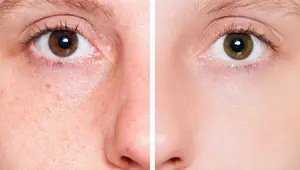
One of the most common procedures offered by cosmetologists in all beauty salons are various types of peelings. They are extremely popular among the fair sex, since they are presented almost as a panacea for absolutely any skin problem. Chemical methods of facial cleansing have been used in cosmetology for many decades, helping to solve problems of various kinds: from getting rid of acne to facial rejuvenation and improving skin structure.
Very often in the list of services at a beauty salon you can find the name “tca peeling”, otherwise it is also called “trichloroacetic acid peeling”. Let us examine in detail what this method of skin cleansing is, who it is suitable for and what problems it copes with.
TCA peeling - what is it?
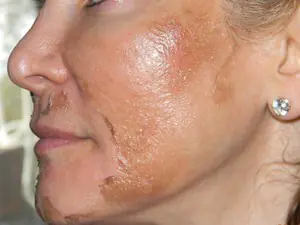
Trichloroacetic peeling is a variant of chemical cleansing of the skin, the main active ingredient of which is trichloroacetic acid. This is a chemical compound of organic origin. It easily dissolves in water, can easily penetrate the layers of the dermis and has bactericidal, anti-inflammatory, cauterizing properties. Is a toxic substance.
The main mechanism of action is as follows: acid molecules are easily absorbed into the deep layers of the epidermis, protein coagulation occurs and intercellular connections are destroyed. Due to this, the dying and exfoliation of the stratum corneum occurs. Along with dead cells, sebaceous plugs and micro-pollutants that clog pores are removed. At the same time, active division of new cells occurs in the deep layers, and the recovery process begins. At this moment, a slight soft tissue burn is visually observed. But after a couple of days, the injured areas are replaced by new healthy epidermal cells.
Attention! The procedure is extremely dangerous to carry out independently at home. Failure to comply with safety rules, hygiene of the session, errors in the concentration of the drug and the length of exposure time can lead to serious health problems and damage the skin forever.
Feasibility of application
The main task of any peeling is to correct cosmetic defects of the skin. When making an appointment with a cosmetologist for this type of care, patients expect to receive:
- qualitative change in the appearance of the skin (smoothness, dullness, healthy complexion, etc.);
- correction of pigmentation and post-acne;
- stabilization of the sebaceous glands and restoration of pH balance;
- lifting effect and tightening of facial contours;
- rejuvenating effect and relief smoothing.
However, TCA medium peeling is primarily a medical procedure, the use of which has a list of specific indications. Most often, to prescribe this type of chemical exposure, the presence of several problem conditions is necessary.
Indications and contraindications for the procedure
The procedure is recommended if:
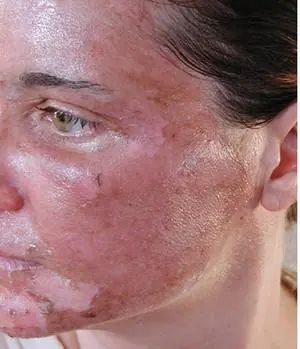
obvious skin defects after chickenpox and acne (scars, pits, post-acne, scars);- hyperkeratosis (unnatural thickening of the skin);
- excessive pigmentation, including freckles;
- skin atrophy in the form of stretch marks (stretch marks);
- small facial wrinkles;
- excessive work of the sebaceous glands, acne;
- enlarged pores, presence of comedones;
- flat birthmarks, nevi;
- melasma;
- change in tone and elasticity.
- dull complexion.
During the consultation, the specialist is also obliged to familiarize the client with the existing restrictions for performing the session.
The procedure will be refused if the following contraindications are present:

the presence of chronic diseases in the acute stage, as well as oncology;- diseases of the endocrine system, including thyroid disease;
- damage by bacterial or parasitic infections (skin mites, streptoderma, impetigo, etc.);
- there is a fungal infection of the skin;
- active inflammatory processes in the treated area;
- ARVI, acute respiratory infections, herpes and other infectious diseases;
- acne treatment with acnecutan and roacquant;
- pronounced rosacea;
- keloid scars;
- vitiligo and pigmentation of large areas of the affected area;
- fresh tan;
- allergic reactions to the composition of the exfoliant;
- pregnancy or lactation period;
- had a negative experience with microdermabrasion and peelings before;
- the presence of wounds, microtraumas of the skin, recent piercing or tattooing;
- clients with phototypes 4-6 according to the Fitzpatrick gradation.
Types of TCA peels
Used in cosmetology solutions of various concentrations. Depending on the percentage and exposure time, the depth of exposure to the skin will differ. Based on the degree of concentration and time of exposure of the drug, it is customary to distinguish between two types of peeling - superficial and medium.
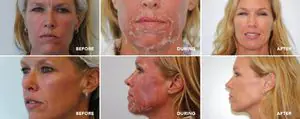
TCA 15 peel means the use of 15% trichloroacetic acid, and the degree of action of the procedure is considered a superficial peel. This is a gentle type of chemical peeling that affects the surface layers of keratinized cells of the epidermis and provides superficial cleansing. In this case, the exposure time on the skin will not exceed 10-15 minutes. But in terms of effectiveness, such a session is superior to the widely used milk, apple, wine, and glycolic AHA peels.- Medium tsa peeling. A more concentrated solution of trichloroacetic acid is used for medium peeling. A saturated 20-35 percent reagent is applied to the surface of the skin and left for 20-30 minutes. As a result of this use of acid, an artificially created chemical burn is formed on the surface of the skin, the degree of which is controlled by a competent specialist. The medium peeling itself is more painful, but the effect of such cleansing is much more noticeable.
- Deep peeling using TCA 40% is not performed due to the high risk of adverse consequences. However, sometimes it is practiced to apply an exfoliant locally to individual areas of the skin, for example, to get rid of benign formations or cosmetic defects.
You need to know that the degree of effect on the skin also depends not only on the concentration of the active substance, but also on parameters such as the number of layers applied to the skin, exfoliation time, additional use of compounds with resoricin, glycolic or salicylic acid. An important role is played by the condition of the patient’s skin before the procedure (presence of minor damage, wounds), as well as pre-peeling preparation.
How to prepare your skin for peeling
Cleansing the skin with trichloroacetic acid is quite a serious medical procedure, for the favorable implementation of which it is necessary to carry out a number of simple measures in advance. The effectiveness of the result, reducing the rehabilitation period and minimizing the risk of complications will depend on this. So, what subtleties need to be taken into account?
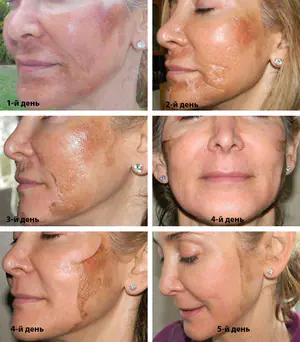
Correct timing. The most optimal time for the procedure will be from the end of October to the beginning of March. In the autumn-winter period, there is much less solar ultraviolet radiation, which can harm the skin and cause hyperpigmentation.- A month before the scheduled event, do not use additional skin cleansers. Eliminate scrubs, gommage, brushes, sponges and sponges from daily use.
- Perhaps the cosmetologist will recommend peeling with AHA acids 2-3 weeks before the procedure.
- Start using cosmetics with fruit acids and sunscreens a couple of weeks before TSA peeling.
- Avoid visiting the solarium, sauna and bathhouse in advance. Postpone eyebrow correction, tattooing and hair removal of the mustache area until the skin is completely restored after peeling.
- To reduce the risk of viral and herpes infections, start taking antiviral medications 5 days before your mid-peel.
- Sometimes it is advisable to use medications that help strengthen capillaries and blood vessels. This will facilitate the rapid restoration of damaged tissues during the rehabilitation period.
Skin care during the recovery period
For skin restoration and rehabilitation After exposure to trichloroacetic acid, a long period is required. Over the next 4-5 weeks, careful and careful care will be required. Damaged skin needs protection from adverse environmental factors, protection from overdrying, dehydration and exposure to pathogens. In addition, for the best result, assistance in activating regeneration processes is necessary.
The entire rehabilitation period can be divided into stages.
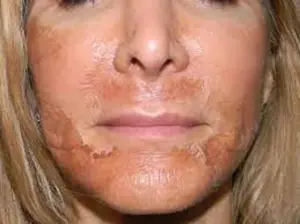
Medium peeling is a manipulation after which significant redness and swelling form on the skin in the first day. You may feel discomfort, tightness and dryness. This condition often lasts for two to three days. A thin film forms on the surface. On the fourth day, the face becomes covered with a dense crust. Under no circumstances should you touch the crust with your hands or try to scrape it! This can lead to infection or injury to the skin before a scar appears.
To alleviate the condition, the cosmetologist will prescribe the necessary moisturizing creams, which will include vitamins, hyaluronic or mandelic acid. In the first two days, using water or any other means to wash your face is strictly prohibited. All liquids will have to be consumed using a straw. Dairy products are excluded from the diet and green tea.
Then the resulting crust will begin to actively peel off, and the exposed skin will noticeably darken. This stage will last about a week. Then all discomfort will disappear.
At the rejection stage it is important:
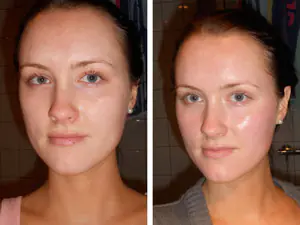
protect your face from exposure to sunlight and ultraviolet radiation;- refuse to visit the sauna, swimming pool and bathhouse;
- do not expose the skin to high and low temperatures;
- do not apply compresses or masks;
- take a break from active physical activity;
- do not wear makeup or use decorative cosmetics.
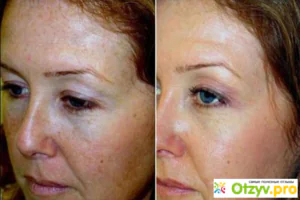
Over the next 2-3 weeks, the skin is completely replaced. Metabolic processes are restored, local immunity is increased, and the rejected epidermis is completely replaced by new young cells. Elastin and calogen fibers are remodulated. Skin appearance is also undergoing changes. The face becomes smoother, the texture is smoothed out, wrinkles and skin defects are less noticeable. Exfoliated cells reveal fresh, rejuvenated and healthy skin.
Care during this period should combine maximum hydration and nutrition. A useful procedure would be mesotherapeutic biorevitalization using hyaluronic acid. This will help restore hydrobalance, elasticity and skin turgor.
Frequency of procedures
Facial cleansing with TCA peeling medium impact gives noticeable results even after a single use. The effect after the procedure can last a significant period of time: from six months to a year. If necessary, a repeat procedure is possible after the end of the recovery stage, but not earlier than after 4 weeks. In this case, it is important to have time to do both sessions in the autumn-winter period.
TCA peeling – excellent rejuvenation or harmful procedure?
What is a TCA peel? This is the name of the procedure for chemical exfoliation of the skin, which is carried out under the influence of trichloroacetic acid. This organic substance dissolves well in ordinary water, so it has excellent cauterizing properties.
Numerous reviews from those who have experienced the effects of TCA peeling, as well as “before” and “after” photos confirm the effectiveness of this procedure. But is this manipulation really that good?
Features of TCA peeling
The first studies of the amazing properties of trichloroacetic acid began in the middle of the last century, when it was found that this substance can reduce the appearance of keloid scars by 25%.
Today, the title of leader in the market of cosmetic products based on trichloroacetic acid is assigned to the Spanish company Skin Rebirth.
In general, peelings are superficial, medium and deep. All of them differ in the depth of exposure to the acid composition.
TCA peeling has an effect on the middle layers of the skin. The abbreviation comes from the English term trichloroacetic acid, which means trichloroacetic (or trichloroethanoic) acid.
The substance is obtained through a laboratory synthesis process - one molecule of acid is combined with three chlorine atoms. The chemical reaction is further stimulated using various catalysts.
It is not recommended to perform more than 1 TCA peeling procedure per year. The fact is that a person runs the risk of skin becoming flaccid and resembling parchment.
Many people are scared by the very phrase acid peeling. But you need to understand that trichloroethanoic acid is absolutely non-toxic. The depth of its penetration into the skin depends on 2 factors:
- Concentration of the active substance in the cosmetic composition (there are different brands of TCA peeling, which contain this acid).
- The number of layers applied during the procedure.
TCA peeling is recommended to be carried out from late autumn to the first third of spring. This is done because at such times the lowest peak of solar activity is observed.
If the procedure is carried out in the summer, a person risks experiencing a burn (since the skin is very delicate) or pigmentation.
Types of procedure
| Name | Depth | Trichloroethanolic acid concentration | Excipients | Action on the epidermis |
|---|---|---|---|---|
| "Easy TCA Peel" | Surface impact | 15% | Ascorbic and citric acids, saponin complex | Auxiliary components significantly enhance the effect of the acid, increase the depth of its penetration into the epidermis, and improve skin microcirculation |
| "TCA Peel solution" | Medium impact (used exclusively on the body, not applied to the face) | 20% | Lactokines, amino acids | Auxiliary components combined with acid stimulate immune defense, relieve inflammation and irritation on the skin |
| "Only Touch Peel" | Deep effects (applied only to certain areas of the epidermis) | 40% | Saponin complex, phytic acid | Additional substances in the cocktail neutralize the overly abrasive effects of acid and improve skin regeneration |
Mechanism of action of trichloroethanol acid
TCA peeling has a complex effect on the epidermis. Among the main properties of trichloroethanol acid are the following:
- Deep cleansing. The top layer of epithelium will look cleansed, smooth and rejuvenated.
- Active regeneration. Trichloroacetic acid has a direct effect on the deep layers of the skin. This starts the process of proliferation - the formation of new, young skin cells. As a result, the renewed epithelial structures become more resistant to various inflammations, diseases, and age-related changes.
- Reducing inflammatory processes. Trichloroethanoic acid, when exposed to human skin, narrows enlarged pores. As a result, the secretion of sebum, which is an ideal environment for bacteria to live and multiply, is reduced.
- Constant stimulation. When the epidermis is exposed to the constituent components of the cocktail, natural metabolic processes in the skin are enhanced and accelerated. Thanks to this, accelerated synthesis of collagen and elastin fibers begins, which are responsible for elasticity, absence of wrinkles and healthy appearance of the skin.
To eliminate scars, scars, the minimum concentration of the active substance should be 30%.
Indications and contraindications for use
Before making an appointment with a cosmetologist for a procedure, you must definitely go for a consultation with a dermatologist, who can objectively assess the condition of the skin and give related recommendations.
In addition, you need to familiarize yourself with the list of contraindications for this type of peeling.
INDICATIONS
- if the patient, as a result of natural age-related changes, has facial wrinkles in the area of the eyes, mouth, cheeks, forehead;
- to reduce excessive secretion of sebum and narrow enlarged pores;
- to remove the consequences of acne - keloids, scars, uneven skin;
- to eliminate stretch marks that appeared on the body after rapid weight loss or pregnancy;
- to reduce noticeable photoaging;
- to reduce visible age-related changes and restore the skin to its former youthful appearance.
CONTRAINDICATIONS
- Inflammatory processes in the area of skin to be treated. Violation of the integrity of this area of the epidermis.
- The presence of herpes infection in the body.
- Increased tendency to form keloid scars.
- Hyperpigmentation.
- Allergy or individual intolerance to any of the components of the cosmetic peeling composition.
- Pregnancy and lactation process.
- The presence of diseases of the endocrine system in the patient, any cancer, dermatological diseases.
- Taking vitamin A in large doses over the past six months.
- Recent tanning of the skin.
- A large number of moles.
- Excessive hair growth.
- Critical days.
- Carrying out procedures that injure the skin during the last 2 months (for example, enzyme, ferul, diamond peeling).
The effect of peeling with trichloroacetic acid depends on the depth of exposure of the active substance in the cocktail, the patient’s age, his level of health, the presence of bad habits and other factors.
Complications
TCA peeling is a traumatic and painful procedure. If you ignore contraindications and do not properly care for your skin, the following complications may occur:
- if the patient had diseases of a herpetic nature, they may worsen;
- in some cases, keloid scars appear on the treated areas of the skin;
- hyperpigmentation of the epidermis begins;
- A noticeable boundary between skin structures (demarcation line) appears on the treated area.
5 procedures for results (preparation)
The TCA procedure is carried out in stages. This is done to achieve optimal results after skin treatment. The number of stages directly depends on the level of peeling depth. The average session lasts approximately 20–40 minutes.
It is important to remember that medium and deep TCA peels are quite painful procedures; while the layers are left on the skin, the patient may feel a strong burning sensation.
During superficial peeling, as a rule, he feels only a slight tingling or tingling, and this does not cause him much discomfort.
The price for TCA peeling is quite affordable - from 2000 rubles for medium skin treatment.
In order to enhance the effect of the procedure, it is recommended to carry out preliminary preparation:
- carrying out glycolic peeling;
- avoiding direct sunlight on the skin;
- constant use of sunscreen;
- taking medications that strengthen the walls of blood vessels;
- refusal of hair removal and the use of scrubs.
Procedure protocol (stages)
Typically, TCA peeling is carried out in 4 interconnected stages.
- Skin cleansing. The cosmetologist, using a soft lotion or foam, will cleanse the client’s skin of makeup residues, sebum, as well as everyday impurities. Thus, the epidermis will be prepared for subsequent processing.
- Applying layers of peeling composition (the number of which depends on the level of peeling depth). 1, 2 or 4 layers can be applied to the patient’s skin alternately. Itching during the procedure is relieved by air flow (for example, a fan.)
- Cleansing and soothing the skin. The doctor will remove the active composition from the epidermis using alkali or acidic water, and apply a product that will soothe the irritated epidermis.
- Post-peeling care.
After the procedure, characteristic white spots may appear on the area of skin treated with trichloroethanol acid (with medium and deep peeling). With superficial peeling, pink spots appear.
You shouldn’t be afraid of them - it’s just the so-called “frosting effect.” It occurs as a result of active coagulation of the skin. The “frosting effect” can be present on the epidermis for 48 hours after the session, after which it will disappear without a trace.
10 guaranteed results of TCA peeling
After TCA peeling, the following changes are observed:
- The relief of the epithelial covers is leveled, they become more elastic and rejuvenated.
- The tone of the epidermis on the face is evened out and improved.
- The manifestations of photoaging disappear.
- Inflammation on the skin is reduced.
- Keloid scars, scars and post-acne scars become less noticeable.
- Acne disappears.
- Sebum secretion decreases.
- Pores become smaller.
- Hyperpigmentation decreases: age spots become lighter or disappear completely.
- Metabolic processes in the skin intensify, and the renewal mechanism is launched.
Question answer
Why is there no result?
I have white spots in the treatment area. What is this?
I have had dry skin for a long time. Why does it feel tight?
Rehabilitation process
Immediately after the procedure, swelling may appear on the skin, it will be dry, painful and tight. A few days after the session, the cosmetologist will begin to see hard brown or brown crusts appear on the skin.
Under no circumstances should you rip them off yourself - this can cause the appearance of keloid scars.
These crusts will begin to fall off within a week after the session. Under them, new, young skin of a light pink hue will appear. After a few days, it will even out its shade and will no longer differ in color and texture from the rest of the epidermis layer on the body.
Trichloroacetic acid is abrasive, and the recovery period after this peel can be more than 2 weeks.
If you cannot afford a short vacation, then it is better to opt for a more gentle peeling. For example, based on salicylic, fruit, lactic or glycolic acids.
TCA peeling is considered one of the most traumatic, but at the same time the most effective procedures. When carrying out superficial peeling (15%), a recovery period is not required at all.
At an average rate (from 20 to 30%), the patient will experience peeling and redness of the epidermis, which goes away after a few days.
At this time, you need to remember some rules:
- Under no circumstances should the treated area of the epidermis be exposed to water for 48 hours after the session. A cosmetologist will prescribe you special soft products (creams, foams, lotions), which will be selected depending on your skin type. To enhance the effect of these cosmetics, a small percentage of fruit acids is often added to their composition, as well as all the vitamins, caring and moisturizing substances necessary for the epidermis.
- Under no circumstances should you go outside for the first time without first treating your skin with sunscreen. The minimum protection factor is SPF 30.
Sometimes cosmetologists additionally recommend biorevitalization based on hyaluronic acid to enhance the effect of peeling with trichloroacetic acid.
Possible side effects (5 troubles)
After this manipulation, in any case, you should expect redness of the skin, swelling, and you also need to be prepared for the skin to begin to peel off.
There have been cases where patients experienced pigmentation, scarring, and allergies. Basically, this happens if contraindications were not taken into account, or the person ignored the doctor’s recommendations.
Thus, after the procedure you may encounter the following troubles:
- Herpes. This problem appears for one simple reason: a person has a tendency to get frequent herpes, but he did not take a course of antiviral drugs at the preparation stage. In this case, you should consult a doctor who will prescribe the appropriate medications.
- Dark spots. They form if the procedure was carried out during a period of increased sun activity, preparation for peeling was not carried out, and the crusts were torn off.
- Acne. This often happens if the doctor chose the wrong session method. It is forbidden to lubricate acne with alcohol-containing products. Medicines against viruses and preparations containing zinc will come to the rescue.
- Allergy. To avoid it, you need to do allergy tests before the manipulation.
- Scars. They often form in those patients who have peeled off the crusts themselves.
Reviews
You can view reviews, as well as photos of the days “before and after” on the Internet and on thematic forums. Here are some of them:
“I have suffered from acne since I was a teenager. It seems that everything has been restored, acne does not appear, but visible marks remain after it.
Every day I covered them with a layer of foundation, but they are still clearly visible. I was once advised to try TCA peeling.
Girls, this is an effective procedure, as after it the condition of the skin has improved, and acne marks have decreased.”
“I have mixed feelings about the TCA peel. Indeed, after it, the pigment spots became lighter, the skin became more tender, and it was renewed. But there is pain during the procedure, recovery takes a long time, and the price is quite high.
I will not recommend such rejuvenation and recovery. I'll probably try a different procedure."
Expert opinion
Irina Dorofeeva
practicing cosmetologist
About 3 days before the planned procedure, it is worth taking a course of antiviral medications that will protect against the occurrence of herpes. This applies to those people who encountered this problem less than six months ago. Do not go to the sauna or solarium a day or two before the procedure. You cannot shave or pluck your eyebrows before peeling. I advise you to prepare well before the mid-peeling. To do this, you need to go through superficial cleansing a couple of times.
Michelle Place
plastic surgeon
During the first week, the face will be covered with a film, which will gradually peel off. You cannot protect yourself from swelling and redness. The main thing is not to peel off the crust, because the future result depends on it. That is why they undergo such a procedure while on vacation. But remember that summer time will not work in this case. Panthenol will help you recover faster.
In modern cosmetology, TCA peeling is considered one of the most promising and effective procedures. It is easy to use, safe, and also guarantees quick and lasting results.



